Serviços Personalizados
Journal
Artigo
Indicadores
-
 Citado por SciELO
Citado por SciELO -
 Acessos
Acessos
Links relacionados
-
 Similares em
SciELO
Similares em
SciELO
Compartilhar
Revista de Ciências Agrárias
versão impressa ISSN 0871-018X
Rev. de Ciências Agrárias vol.42 no.1 Lisboa mar. 2019
https://doi.org/10.19084/RCA18106
ARTIGO
Zinc supply methods and doses for corn1
Métodos de fornecimento e doses de Zinco para o milho
Carlos Felipe Fernandes and Flávio Carlos Dalchiavon*
Instituto Federal de Educação, Ciência e Tecnologia de Mato Grosso-Campus Campo Novo do Parecis, curso de Bacharelado em Agronomia, MT 235, km 12, Zona Rural, 78360-000 Campo Novo do Parecis MT Brazil
1This paper has been retrieved from a monograph written by the first author.
(*E-mail: flavio.dalchiavon@cnp.ifmt.edu.br)
ABSTRACT
Deficiency of the micronutrient Zinc (Zn) is a limiting factor for corn productivity and its lack is a notorious factor in the Brazilian savannah. Current research, analyzing the best method and dose to be supplied to corn in the region, was performed on the experimental field of the Instituto Federal de Mato Grosso, campus Campo Novo do Parecis MT Brazil. Sowing occurred on the 11th March 2017, with corn variety NS90, and harvest on the 24th July 2017. Design consisted of randomized blocks, with a 2 x 5 factorial scheme, with 4 replications, or rather, 2 supply forms (application to soil and to leaves, at vegetative stage 4 – fourth leaf) and 5 doses of Zn (0; 0.25; 0.50; 0.75; 1.0 kg ha-1). Corn´s vegetative and reproductive characteristics were evaluated. Analysis of variance (F-test) and regression test were undertaken (p<0.05). Zn provided via leaf increased stalk diameter, insertion height and spike length. Reduction in the mass of one thousand grains and grain productivity occurred for increasing Zn doses. Zn is highly relevant for the development of corn and its supply provides significant responses to the above-mentioned variables.
Keywords: Savannah, micronutrient, corn yield, grain yield, Zea mays L.
RESUMO
A deficiência do micronutriente Zinco (Zn) é considerada um fator limitante à produtividade da cultura do milho, sendo que a ausência deste elemento é encontrada em toda a região do Cerrado. Objetivou-se com esta pesquisa evidenciar o melhor método e dose de Zn a ser fornecida ao milho. O trabalho foi realizado no Campo experimental do IFMT campus Campo Novo do Parecis – MT. A semeadura ocorreu no dia 11 de março de 2017, com a variedade de milho NS90, e a colheita realizada em 24 de julho de 2017. Utilizou-se delineamento em blocos casualizados, em esquema fatorial 2 x 5, com 4 repetições, sendo 2 formas de fornecimento (sulco de semeadura e foliar, no estádio vegetativo 4 – quarta folha) e 5 doses de Zn (0; 0,25; 0,50; 0,75 e 1,0 kg ha-1). Foram avaliadas as características vegetativas e reprodutivas do milho. Realizou-se a análise de variância (teste F) e de regressão (p<0,05). O Zinco fornecido via foliar incrementa o diâmetro de colmo, altura de inserção e comprimento de espiga. Há decréscimo da massa de mil grãos e produtividade de grãos para doses crescentes de Zinco. O Zinco é de extrema importância para o desenvolvimento da cultura do milho, pois seu fornecimento proporciona respostas significativas para as variáveis mencionadas.
Palavras-chave: Cerrado, micronutriente, milho safrinha, produtividade de grãos, Zea mays L.
INTRODUCTION
Indian corn or maize (Zea mays L.) is one of the main crops cultivated by humans. It is greatly important for human and animal consumption and a relevant energy source worldwide, especially in developing countries (Osório et al., 2015). Corn is economically significant in Brazil and it is widely cultivated in several states. According to the Brazilian Supply Company (CONAB, 2017), corn production in Brazil reached 97.7 million tons for the 2016-2017 harvest.
The development and productivity of crops are affected by several factors among which nutritional imbalance, especially micronutrients, may be underscored. Araújo and Silva (2012) register that Zn is a limiting micronutrient, due to its low concentration in the soil. Zn is frequently hidden in clay, ranging between 30 and 60% of total, while part of it is adsorbed in organic matter. However, Zn may be supplied by seed treatment, through the leaves, or indirectly by application to the soil (Gonçalves Júnior et al., 2007). Since Zn has low or no mobility in the soil, its absorption by plants is difficult, especially during the vegetative stages when demand is greater. Due to such effects, other means, such as supply through the leaves, have been employed to avoid the occurrence of visible or hidden deficiencies that would compromise crop´s development (Marióstica and Feijó, 2013).
When Ferreira (2012) researched deficiency symptoms of macro- and micro-nutrients in corn, the author reported low Zn mobility in the phloem and, consequently, distribution limitations in the plant. Since Prado (2013) registered that Zn has high mobility in the phloem, it became clear that there was a deep divergence on the mobility of the nutrient in the plant. Several research works evidenced a rise in productivity in several cultures (common beans, castor beans and soybeans) when Zn in supplied at different doses and in different methods (Cardoso et al., 2013; Inocêncio et al., 2015). When the nutrient is provided in inadequate doses, in excess or lack, interference in growth, development, productivity and modifications in cell metabolism may occur (Santos et al., 2012). Further, plants fertilized with balanced doses resist environmental adversities and produce a greater number of good-quality seeds (Zucareli et al., 2011; Meneghete et al., 2017). Consequently, micronutrients cannot be discarded. Plants performance depends on the balanced supply of all elements, including those with very low demand (Salimpour et al., 2010).
In spite of the importance of Zn for corn, the supply method should be better determined. Corn requires relatively low amounts of Zn, but there are several difficulties in providing the nutrient uniformly. Therefore, current study investigates the best Zn dose and method to be supplied to corn.
MATERIALS AND METHODS
Current assay was performed at the Instituto Federal de Educação, Ciência e Tecnologia de Mato Grosso (IFMT), on the campus Campo Novo do Parecis MT Brazil, at 13°4031S; 57°5331W, and mean altitude 574 m. According to Köppen, the region´s climate is Aw, or tropical climate, with rainless winters and rains in summer. The dry and wet seasons are well defined, with the former ranging between May and September, and the latter between October and April (Dallacort et al., 2011).
According to the Brazilian System for Soil Classification (Santos et al., 2013), the soil of the experimental area is Dystrophic Red Latosol, with slightly rolling hills and good drainage. Prior to sowing, ten soil samples were collected at layers ranging between 0 and 0.20 m deep. The composed sample determined soil fertility and revealed the following properties: pH (CaCl2) = 5.7; O.M. = 22.7 mg dm-3; P = 12.6 mg dm-3; K, Ca, Mg and H+Al = 66.8 mg dm-3; 1.75 cmolc dm-3, 0.66 cmolc dm-3, 3.40 cmolc dm-3, respectively; V = 43.14%.
The area was covered with 600 L drift spray with 2 kg ha-1 of ammonium glyphosate salt, on the 14th October 2016. Liming (1500 kg ha-1 lime, PRNT 80%) was applied on the 12th December 2016, following soil analysis and recommendations by Souza and Lobato (2004).
Assay design comprised randomized blocks, factorial scheme 2 x 5, with 4 replications. The first factor comprised the method Zn was supplied (in the soil on seeding or on leaves at stage V4 – fourth leaf). The second factor comprised Zn doses (0; 0.25; 0.50; 0.75; 1.00 kg ha-1). The two supply types were done by a 5L-shoulder sprayer for better distribution. Zn source was zinc oxide (40% Zn and 1% N). Each plot measured 3.15 x 7 m, totaling 22.05 m², with 7 rows of seeds, spaced 0.45 m and sowing density at 66,666 plants per hectare.
Scarification and subsoiling to improve the soils physical characteristics were done on the 11th March 2017. Seeds were sown by a seven-drill mechanical sower. Basic fertilization comprised 250 kg ha-1 of 10-30-20 (N-P2O5-K2O), with an expected yield of 8,000 kg ha-1 (Souza and Lobato, 2004). Covering fertilization was done manually by launching the product at 60 kg ha-1 N (urea), in two applications, at V4 and V7 (seventh leaf).
Corn hybrid NS 90 VT PRO2 was employed, resistant to ammonium glyphosate salt and to the fall armyworm Spodoptera frugiperda, Helicoverpa zea and Elasmopalpus lignosellus. Industrial treatment of the seed comprised deltametrin 25 g L-1 (8.0 mL for 100 kg seeds) + pirimiphos-methyl 500 g L-1 (1.6 mL for 100 kg of seeds) + metalaxyl-M 20 g L-1 (150 mL for 100 kg of seeds), tiabendazole 150 g L-1 (150 mL for 100 kg of seeds) + fludiaxonil 25 g L-1 (150 mL for 100 kg of seeds). Additionally, seeds were treated with fipronil 250 g L-1 (50 mL for 100 kg of seeds).
Immediately after sowing, a sample of each treatment was collected at layers between 0 and 0.20 m deep to quantify Zn rates in the soil. Rates were 5.3; 6.3; 6.5; 6.0 and 6.2 mg dm-3 for plots which received Zn through the soil, and 5.6; 6.6; 6.9; 6.2 and 6.0 mg dm-3 for plots which received Zn through the leaves.
Control of pests, diseases and invading weeds was undertaken at V4. Thiamethoxam 141 g L-1 + lambda-cyhalothrin 106 g L-1 (250 mL ha-1) were used to control the armyworm (Spodoptera frugiperda); pyraclostrobin 26 g L-1 + epoxyconazol 160 g L-1 (300 mL ha-1) were used to control the leaf spot (Phaeosphaeria maydis); ammonium glyphosate salt 792 g kg (2000 g ha-1) was employed to control invading weeds.
The following evaluations of corn were undertaken within the useful area (3 central rows with six meters), with six plants per plot: height of plant: at stage pasty grain (R3), measured from ground level up to the base of the leaf axil; height of spike insertion: in R3, measured from ground level up to spike base; stalk diameter obtained by digital caliper, at 5 cm from the ground. Green mass in five plants, continuous in the row, was determined during flowering (R1). They were then dried in a forced air buffer (65°C) till constant mass. Weight of dry matter was calculated. Ten spikes were harvested manually at physiological maturity (R6) on the 24th July 2017. They were retrieved from the plot´s planted area to determine the diameter of the spike by digital caliper, measuring the spike´s middle third section; length of spike was measured by ruler; number of grain rows per spike; mass of one thousand grains by counting and weighing; grain productivity calculated by weighing the total mass of grains obtained from the entire useful area of the plot after threshing; they were measured for kg ha-1, with correction of grain humidity at 13% (wet base), following Dalchiavon et al. (2011):
PR = P.[(100-Uob) / (100 – Ud)] (1)
where PR is the corrected grain mass (kg ha-1); P is the grain mass on the field (not corrected) (kg ha-1); Uob is the humidity of each plot (%); Ud is the desired standard humidity (13%).
Data underwent analysis of variance (F-test) for supply forms and regression analysis was employed for supplied Zn doses, at 5% probability, with statistical program Sisvar (Ferreira, 2011).
RESULTS AND DISCUSSION
Mean rates for maximum, medium and minimum temperatures were 30.9; 22.7 and 17.1°C respectively, with rainfall rate at 510.4 mm (Figure 1). These rates attended to the crops hydric demand, since it required an accumulated rainfall between 450 and 800 mm, regularly distributed throughout the cycle (Bergamaschi and Matzenauer, 2014).
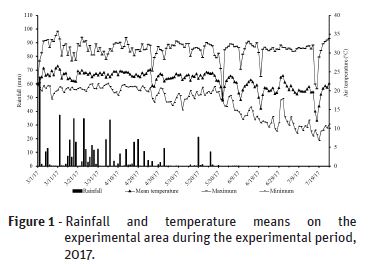
Regardless of form and dose, the application of Zn failed to provide a significant increase in plant height (PH), diameter of spike (DS), grain rows per spike (GR), green mass (GM) and dry mass (DM) (Table 1). The above may be due to the initial Zn rates in the soil, corroborated by Muner et al. (2011).
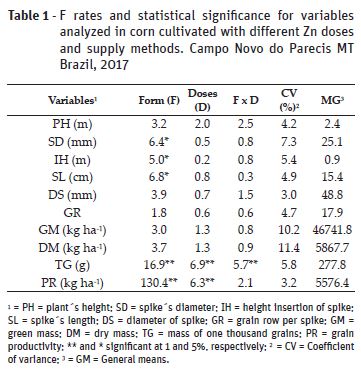
In the case of non-significant variables, general means (GM) and coefficients of variance (CV) for PH were respectively 2.4 m and 4.2% (Table 1); 48.8 mm and 3.0% for DS; 17.9 and 4.7% for GR; 46741.8 kg ha-1 and 10.2% for GM; 5867.7 kg ha-1 and 11.4% for DM. However, there was a significant effect for Zn supply method and dose for variables stalk diameter (SD), spike insertion height (IH), spike length (SL), mass of one thousand grains (TG) and grain productivity (GP) (Table 1). Leaf-supplied Zn provided greater development for SD, IH and SL, with a respective increase of 6.2; 12.5 and 4.0%, when compared to supply through soil (Table 2).
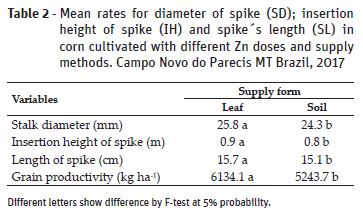
According to Serra et al. (2011), glyphosate decreases Zn rates in plants and may have jeopardized performance of the plants´ DC, IH and SL when the nutrient was applied through the soil during sowing (prior to the application of glyphosate for the control of invading plants). The above contrasted Zn supply through leaves at V4 (after the application of glyphosate) and may have been the cause of a greater accumulation through Zn leaf application (23.1 mg dm-3 when nutrient was supplied by leaf application and 19.6 mg dm-3 by soil application), with direct influence on the variables under analysis. The best vegetal development by Zn leaf application may be associated to the nutrient´s important role as the component of several enzymes and formation of auxins which cause vegetal growth (Taiz et al., 2017).
In his research on Zn doses (0; 1.0; 2.5; 5.0; 10.0 kg ha-1) supplied at corn sowing during the summer in Manaus AM Brazil, Abreu (2012) did not report any significant effect for variables PH and IH, respectively with means 2.12 m and 1.08 m, in contrast to current study with regard to the latter.
Further, Abreu et al. (2016) evaluated Zn doses (0; 1.0; 2.5; 5.0; 10.0 kg ha-1) supplied through soil immediately at the sowing of summer corn in Iranduba AM Brazil, and did not report any significant effect for IH and SL. However, mean rates (1.08 m and 14.8 cm, respectively) were close to those in current study (Table 2). This fact was corroborated by Steiner et al. (2011) in their analysis of Zn doses through soil (0; 5.0; 10.0 kg ha-1) for the agronomic performance of inter-harvest corn in Mercedez PR Brazil. The authors did not register any significant effect for IH (0.8 m) and SD (29.4 mm).
It has been observed that in the interface between supply forms and Zn doses (Table 3), interaction occurred only for doses above 0.75 kg ha-1 for TG. Supply through leaf revealed heavier grains and thus higher grain productivity rates, regardless of the dose. The above proved the importance of Zn supply by leaf application, especially with hybrid corn RR, due to the effect of glyphosate in the metabolism of the nutrient (Taiz et al., 2017). Farinelli and Lemos (2012) corroborated the above when they reported that grain mass is a characteristic influenced by Zn availability and adequate forms, among other factors.
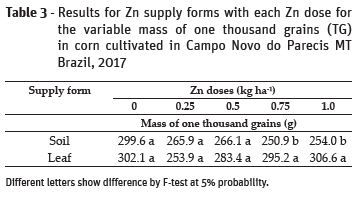
In their study on TG and PR in Zn doses applied to the soil at sowing, Steiner et al. (2011) reported significant results for these variables, respectively at 266 g and 5465 kg ha-1, for dose 10 kg ha-1.
An inverse effect was registered between Zn supply applied to soil and thousand grain mass (Figure 2a). Or rather, the greater the Zn dose, the less was TG, with rates between 288.54 and 246.06 g, whereas Zn doses ranged between 0 and 1.0 kg ha-1. Since there was a 17.3% decrease in grain mass, the above clearly demonstrated the negative/toxic effect of Zn excess (Oliveira and Oliveira, 2011). According to Prado et al. (2007), either a reduction in productivity may occur when Zn is absorbed in excess or there is no positive effect in corn performance by increasing doses due to sufficiency of Zn in the soil (Muner et al., 2011).
Besides the occurrence of toxic effect by excess of Zn in the soil, a nutritional imbalance may occur, which interferes in the absorption of other nutrients, causes lignification of the plant, restricts growth of the secondary cell wall and reduces radicular growth, affecting the absorption of nutrients in general (Cunha et al., 2008; Oliveira and Oliveira, 2011). In the case of the variable TG, Abreu et al. (2012) reported a greater mass rate (307.55 g) when Zn was not supplied by leaf application. However, increasing Zn doses caused linear TG decreases, corroborating data from current analysis (Figure 2a). Soares et al. (2003) showed that the toxicity of some elements, such as Zn, may reduce grain mass of corn plants in the field.
In their research on grain mass and corn productivity as a response to Zn doses (0; 10; 20 kg ha-1) in Marechal Cândido Rondon PR Brazil, Gonçalves Júnior et al. (2007) failed to obtain significant results for TG and PR. They attributed this result to the adequate amount of Zn in the soil. Abreu et al. (2016) applied doses 0; 1.0; 2.5; 5.0; 10 kg ha-1 of Zn in the soil and did not obtain any significant results for PR, with mean 4378.0 kg ha-1. Results were different from those in current study, with greater PR rate (5785.5 kg ha-1) at dose 0 kg ha-1 (Figure 3). However, PR decreased when increasing doses were supplied.
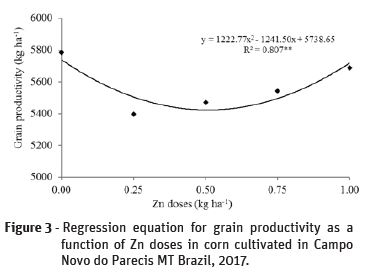
High grain yield responses occurred in soils with great Zn deficiency (Joy et al., 2015). Consequently, productivity responses are greatly dependent on Zn rates in the soil and foregrounds results obtained.
CONCLUSIONS
The application of Zn on leaves increases stalk diameter, spike´s insertion height and spike´s length.
The mass of one thousand grains and grain productivity decrease with increasing doses of Zn.
Zinc is highly relevant for the development of corn and its supply provide significant responses to the variables analyzed.
References
Abreu, D.J.A.A.; Gonçalves, J.R.P.; De Melo, S.A.; Oka, J.M. and Senra, T.V. (2016) - ZINCO: Necessário para a produção de milho em solo de várzea (Iranduba) Amazonas. Revista de Educação Ciência e Tecnologia do IFAM, vol. 10, n. 2, p. 120-134. [ Links ]
Abreu, J.A.A.D. (2012) - Doses de Zinco em dois genótipos de milho em gleissolo háplico no município de Iranduba-AM. Master´s Dissertation in Tropical Agronomy. Manaus, Universidade Federal do Amazonas faculdade de ciências Agrárias. 72 p. [ Links ]
Araújo, E.O. and Silva, M.A.C. (2012) - Interação boro e zinco no crescimento, desenvolvimento e nutrição do algodoeiro. Revista Brasileira de Ciências Agrárias, vol. 7, n. 1, p. 720-727. http://dx.doi.org/10.5039/agraria.v7isa1848 [ Links ]
Bergamaschi, H. and Matzenauer, R. (2014) - O milho e o clima. Porto Alegre: Emater/RS-Ascar. p. 85. [ Links ]
Cardoso, F.R.; Galante, A.H.; Teixeira, I.R.; Da Silva, A.G. and dos Reis, E.F. (2013) - Fontes e doses de zinco na nutrição e produção de feijão-comum e mamona em consórcio. Revista Brasileira de Ciências Agrárias, vol. 8, n. 4, p. 602-609. http://dx.doi.org/10.5039/agraria.v8i4a3417 [ Links ]
Cunha, K.P.V.; Araújo, N.C.W.; Magalhães, M.P.R.; Aguiar, A.A.M.D. and Silva, A.J.D. (2008) - Disponibilidade, acúmulo e toxidez de cádmio e zinco em milho cultivado em solo contaminado. Revista Brasileira de Ciência do Solo, vol. 32, n. 3, p. 1319-1328. http://dx.doi.org/10.1590/S0100-06832008000300039 [ Links ]
CONAB (2017) - Acompanhamento de safra brasileira de grãos, safra 2016/2017: 12º Levantamento da Safra de Grãos. 154 p. Companhia Nacional de Abastecimento. [cit. 2017-10-15]. <http://www.conab.gov.br/OlalaCMS/uploads/arquivos/17_09_12_10_14_36_boletim_graos_setembro_2017> [ Links ]
Dalchiavon, F.C.; Carvalho, M.P.; Freddi, O.S.; Andreotti, M. and Montanari, R. (2011) - Variabilidade espacial da produtividade do feijoeiro correlacionada com atributos químicos de um Latossolo Vermelho Distroférrico sob sistema de semeadura direta. Bragantia. vol. 70, n. 4, p. 908-916. http://dx.doi.org/10.1590/S0006-87052011000400025 [ Links ]
Dallacort, R.; Martins. J.A.; Inoue, M.H.; Freitas. P.S.L. and Coletti, A.J. (2011) - Distribuição das chuvas no município de Tangará da Serra, médio norte do Estado de Mato Grosso, Brasil. Acta Scientiarum Agronomy, vol. 33, n. 2, p. 193-200. http://dx.doi.org/10.4025/actasciagron.v33i2.5838 [ Links ]
Farinelli, R. and Lemos, L.B. (2012) - Nitrogênio em cobertura na cultura do milho em preparo convencional e plantio direto consolidado. Pesquisa Agropecuária Tropical. vol. 42, n. 1, p. 63-70. [ Links ]
Ferreira, D.F. (2011) - Sisvar. A Computer Statistical Analysis System. Ciência e Agrotecnologia. vol. 35, n. 6, p. 1039-1042. http://dx.doi.org/10.1590/S1413-70542011000600001 [ Links ]
Ferreira, M.M.M. (2012) - Sintomas de deficiência de macro e micronutrientes de plantas de milho híbrido BRS 1010. Revista Agro@mbiente On-line, vol. 6, n. 1, p. 74-83. http://dx.doi.org/10.18227/1982-8470ragro.v6i1.569 [ Links ]
Gonçalves Júnior, A.C.; Trautmann, R.R.; Marengoni, N.G.; Ribeiro, O.L. and Santos, A.L. (2007) - Produtividade do milho em resposta a adubação com NPK e Zn em Argissolo Vermelho-Amarelo Eutrófico e Latossolo Vermelho Eutroférrico. Ciência e Agrotecnologia, vol. 31, n. 4, p. 1231-1236. http://dx.doi.org/10.1590/S1413-70542007000400043 [ Links ]
Inocêncio, M.F.; De Resende, Á.V.; Neto, A.E.F.; Veloso, M.P.; Ferraz, F.M. and Hickmann, C. (2012) - Resposta da soja à adubação com zinco em solo com teores acima do nível crítico. Pesquisa Agropecuária Brasileira, vol. 47, n. 10, p. 1550-1554. http://dx.doi.org/10.1590/S0100-204X2012001000020 [ Links ]
Joy, E.J.; Stein, A.J.; Young, S.D.; Ander, E.L.; Watts, M.J. and Broadley, M.R. (2015) - Zinc-enriched fertilizers as a potential public health intervention in Africa. Plant and Soil, vol. 389, n. 1-2, p. 1-24. http://dx.doi.org/10.1007/s11104-015-2430-8 [ Links ]
Maróstica, L.H.B. and Feijó, S. (2015) - Efeito da Adubação Foliar no Período Vegetativo da Cultura do Milho (Zea mays). Uniciências, vol. 17, n. 1, p. 37-40. [ Links ]
Muner, D.L.H.; Ruiz, H.A.; Venegas, V.H.; Neves, J.C.; Freire, F.J.D.S.F. and Maria, B.G. (2011) - Disponibilidade de zinco para milho em resposta à localização de fósforo no solo. Revista Brasileira de Engenharia Agrícola e Ambiental, vol. 15, n. 1, p. 29-36. http://dx.doi.org/10.1590/S1415-43662011000100005 [ Links ]
Meneghette, H.H.A.; Lazarini, E.; Bossolani, J.W.; Parra, L.F. and Hayashi, F.K. (2017) - doses of phosphorus and potassium in peanut plant in the presence and absence of foliar fertilization. Revista Brasileira de Engenharia de Biossistemas, vol. 11, n. 2, p. 125-134. http://dx.doi.org/10.18011/bioeng2017v11n2p125-134 [ Links ]
Oliveira, I.P. and Oliveira, L.C. (2011) - Metais pesados. Revista Eletrônica Faculdade de Iporá, vol. 1, n. 1, p. 59-86. [ Links ]
Osório, C.W.; Bardiviesso, D.M.; De Souza, E.I.S.; Da Costa Leite, R.; Leal, A.J.F. and de Souza, H.M. (2015) - Milho RR submetido a diferentes manejos de herbicidas e adubação foliar. Nativa, vol. 3, n. 2, p. 78-82, 2015. http://dx.doi.org/10.14583/2318-7670.v03n02a01 [ Links ]
Prado, R.M.; Romualdo, L.M.; Rozane, D.E.; Vidal, A.A. and Marcelo, A.V. (2007) - Modos de aplicação de zinco na nutrição e na produção de matéria seca do milho BRS 1001. Bioscience Journal. vol. 24, n. 1, p. 67-74. [ Links ]
Prado, C.H.B.A. (2013) - Aquisição dos nutrientes minerais na solução do solo. Ed. 1. Editora Expressa, p. 188. [ Links ]
Salimpour, S.; Khavazi, K.; Nadian, H.; Besharati, H. and Miransari, M. (2010) - Enhancing phosphoous availability to canola (Brassica napus L.) using P solubilizing and sulfur oxidizing bacteria. Australian Journal of Crop Science, vol. 4, n. 5, p. 330-334. [ Links ]
Santos, R.F.; Isobe, M.T.C.; Lalla, J.G.; Haber, L.L.; Marques, M.O.M. and Ming, L.C. (2012) - Composição química e produtividade dos principais componentes do óleo essencial de Baccharis dracunculifolia DC. em função da adubação orgânica. Revista Brasileira de Plantas Medicinais, vol. 14, n. especial, p. 224-234. http://dx.doi.org/10.1590/S1516-05722012000500017 [ Links ]
Santos, H.G.; Jacomine, P.K.T.; Anjos, L.H.C. dos; Oliveira, V.A.; Lumbreras, J.F.; Coelho, M.R.; Almeida, J.A.; Cunha, T.J.F. and Oliveira, J.B. (2013) - Sistema brasileiro de classificação de solos. 3.ed. Brasília: Embrapa, 353 p. [ Links ]
Serra, A.; Marchetti, M.E.; Candido, A.C.D.S.; Dias, A.C.R. and Christoffoleti, P.J. (2011) - Glyphosate influence on nitrogen, manganese, iron, copper and zinc nutritional efficiency in glyphosate resistant soybean. Ciência Rural. vol. 41, n. 1, p. 77-84. http://dx.doi.org/10.1590/S0103-84782011000100013 [ Links ]
Souza, D.M.G. and Lobato, E. (2004) - Calagem e adubação para culturas anuais e semiperenes. 2º ed. Brasilia, Embrapa, Correção do solo e adubação, 416 p. [ Links ]
Soares, M.A. (2003) - Influência de nitrogênio, zinco e boro e de suas respectivas interações no desempenho da cultura de milho. Dissertação de Mestrado em Agronomia/Fitotecnia. Piracicaba, Escola Superior de Agricultura Luiz de Queiroz, 92 p. [ Links ]
Steiner, F.; Zoz, T.; Junior, A.S.P.; Frandoloso, J.F.; Ruppenthal, V. and Janegitz, M.C. (2011) - Zinco e nitrogênio no desempenho agronômico do milho safrinha. Global Science na Technology, vol. 4, n. 2 p. 9-17. [ Links ]
Taiz, L.; Zeiger, E.; Moller, I.M. and Murphy, A. (2017) - Fisiologia e desenvolvimento vegetal. 6. ed. Porto Alegre, Artmed, 888 p. [ Links ]
Zucareli, C.; Prando, A.M.; Ramos Junior, E.U. and Nakagawa, J. (2011) - Fósforo na produtividade e qualidade de sementes de feijão Carioca Precoce cultivado no período das águas. Revista Ciência Agronômica, vol. 42, n. 1, p. 32-38. http://dx.doi.org/10.1590/S1806-66902011000100005 [ Links ]
Acknowledgements
The authors would like to thank the Research Group in Phytotechny (GPF) of the Federal Institute of Education, Science and Technology of Mato Grosso (IFMT), campus Campo Novo do Parecis, for its collaboration in current assay.
Received/recebido: 2018.04.15
Accepted/aceite: 2018.09.19














